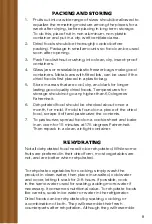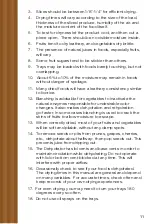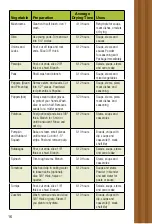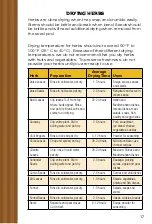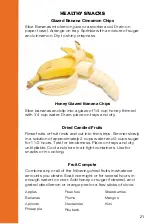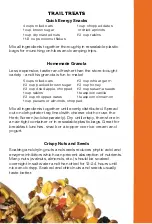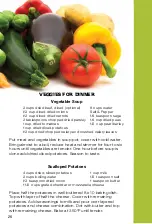
11
3. Slices should be between 1/8”-1/4” for efficient drying.
4. Drying times will vary according to the size of the load,
thickness of the sliced produce, humidity of the air, and
the moisture content of the food itself.
5. To test for dryness let the product cool, and then cut a
piece open. There should be no visible moisture inside.
6. Fruits tend to dry leathery, and vegetables dry brittle.
7. The presence of natural juices in foods, especially fruits,
will vary.
8. Some fruit sugars tend to be stickier than others.
9. Trays may be loaded with foods barely touching, but not
overlapping.
10. About 6% to 10% of the moisture may remain in foods
without danger of spoilage.
11. Many dried foods will have a leathery consistency similar
to licorice.
12. Blanching is advisable for vegetables to inactivate the
natural enzymes responsible for undesirable color
changes. It also makes dehydration and rehydration
go faster. In some cases blanching is used to crack the
skins of fruits to allow moisture to escape.
13. When correctly dried, most of your fruits and vegetables
will be soft and pliable, without any damp spots.
14. To remove seeds or pits from prunes, grapes, cherries,
etc., dehydrate about halfway- then pop seeds out. This
prevents juice from dripping out.
15. The Dehydrator has lid vents and base vents in order to
maintain circulation while dehydrating. Do not operate
with lid or bottom vent blocked at any time. This will
interfere with proper airflow.
16. Occasionally check to see if your food is dehydrated.
The drying times in this manual are general and depend
on many variables. For accurate times, check often and
keep records of your own drying experiences.
17. For even drying, you may need to turn your trays 180
degrees every so often.
18. Do not use oil sprays on the trays.
Summary of Contents for Turbo Food Dehydrator
Page 19: ...19 Fruit Recipes...
Page 25: ...25 Vegetable Recipes...
Page 31: ...31 Jerky Recipes...
Page 35: ...35 Arts and Crafts...









